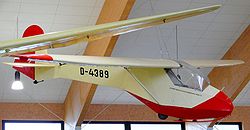Design and development
Fritz Raab, who had designed gliders before World War II, recognised a postwar need for a low cost trainer aircraft. Rather than reproduce the low-performance, single-seat, open-frame primary gliders of the 1930s, he aimed for a design that could act both as a trainer and as a useful gliding club single-seater with respectable performance. Simplicity of rigging was a priority. The result was the Doppelraab, which some have described as a 1½-seater because of its rudimentary instructor's position. It is a strut-braced high-wing monoplane with a mixed metal-and-wood frame and plywood and fabric covering. [1] [2] [3]
The centre section of the wing has a constant chord, with a plywood-covered D-box forward of the main spar. The ply covering extends to the trailing edge at the wing roots over the triangular area defined by the internal drag strut. The outer panels continue the leading edge ply-covered D-box but incorporate curved ailerons, giving the wing an approximately elliptical planform. Where not ply-surfaced, the wing is fabric-covered. Most production aircraft have mid-chord spoilers on the inner section upper surface. Lift and landing forces are borne by faired struts from the lower fuselage to the main spar close to the end of the wing centre sections. [2] [3]
The Doppelraab has a pod-and-boom style fuselage, though the wood-framed, ply-skinned boom is quite deep and has a triangular section. The fabric-covered, parallel chord horizontal tail, carrying separate elevators, is mounted on top of the fuselage. The fin is narrow and ply covered but mounts a broad, fabric-covered rudder which extends below the bottom of the fuselage, where a small underfin protects it and carries a small tailskid. Forward of the wing trailing edge the fuselage becomes much deeper and is metal framed, forming the cockpit. In the prototype, the student's position was conventional and provided with a windscreen of single curvature and with open sides; the instructor squeezed into a small space behind the student and sat astride a pillion seat in a kneeling position, his weight partly supported by knee pads on either side of the forward seat. He could reach over the pupil to the top of an extended control column and his feet pointed backwards to rest on a duplicate rudder bar. Later production machines retain this layout but have a completely enclosed canopy and a slightly raised, bench type instructor's seat. The early prototypes experimented with both forward monowheel and bicycle undercarriages but the production aircraft settled on a rearward placed monowheel with a long forward skid. [1] [2] [3]
The Doppelraab first flew on 5 August 1951. As well as the early cockpit and undercarriage, the V-0 first prototype had unusual airbrakes, formed by rotating the wing strut fairings through 90°. This system, introduced to expedite rigging, [1] was found unsatisfactory and was abandoned in favour of spoilers. The second prototype, the V-1, initially had a two-wheel undercarriage, later altered by the replacement of the front wheel by an extended noseskid (V-1a). The V-2 and V-3 introduced the rear bench seat. [3] The V-3 acted as the prototype for the first production version, the Doppelraab III, though only a few of them were built. The most numerous variant was the Doppelraab IV. Though detail improvements were introduced in the Doppelraab V, no major changes came before the final versions VI and VII. These had wings of 640 mm (25.2 in) greater span and correspondingly increased wing area. The empty weight of the version VI was increased by only 7 kg (15.4 b) but by flying with a higher wing loading this model could provide a 25 kg (55 lb) increase in useful load. [3]
Operational history
The Doppelraab appeared in public for the first time at the first postwar Wasserkuppe competition, held in 1951. It was enthusiastically received, Hanna Reitsch saying that it was "a dream of an aircraft". [4] Its thermal soaring was judged competitive with the Grunau Baby. [4] After a year twelve were flying with fifty in production; final production was close to four hundred. Serial production was handled by Wolf Hirth; both kits and finished aircraft were available. [2] The forward fuselage frame was factory welded in either case. [3] After gaining experience with his instructor, a pupil could fly the Doppelraab solo to gain his early badges, minimising the club's costs. [2]
Production licences were granted in both Americas, Africa and the Near East; one Doppelraab flew as far north as Spitsbergen. [3]
In 2010 twenty-two Doppelraabs remained on the civil aircraft registers of European countries, one in Belgium, one in the Netherlands, one in Spain and the rest in Germany. [5]
This page is based on this
Wikipedia article Text is available under the
CC BY-SA 4.0 license; additional terms may apply.
Images, videos and audio are available under their respective licenses.

